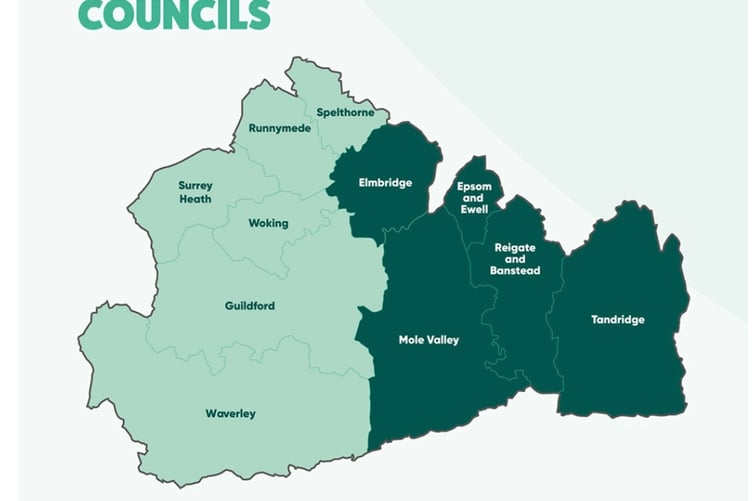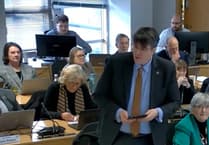Big changes are coming to how local services are run in Surrey. The Government’s decision to scrap all of Surrey’s 12 councils and replace them with two super councils marks the biggest shakeup in local government for 50 years.
It all may sound a bit abstract but here is how it could affect your day-to-day life, from bin collections to council tax bills.
Currently, Surrey has a confusing two-tier system where the county runs things like roads, social care and schools, whereas the district and borough councils manage bins, planning, housing and leisure.

Under the new reorganisation plans, the existing 12 councils will be dissolved and replaced with just two unitary authorities. Elmbridge, Tandridge, Epsom and Ewell, Reigate and Banstead as well as Mole Valley will make up East Surrey, with Guildford, Woking, Runneymede, Spelthorne, Surrey Heath and Waverley making up the West.
East and West Surrey will be individually responsible for everything from pot holes to planning, libraries and leisure. Residents will only have to deal with one council instead of two, so no more being passed between the county and the local borough when you need something done.
Why is this happening?
In short, the overhaul is to save money and streamline efficiency. Between them, Surrey’s councils have over £5 billion in debt with Woking Borough Council bankrupt and others struggling.
The main idea, the Local Democracy Reporting Service understands, is that two large councils will be cheaper to run and more financially resilient, and better able to attract investment than 12 smaller ones.
Will council tax change?
Almost definitely but not straight away. Each of the 12 existing councils charge slightly different rates. Over time these are likely to be ‘harmonised’ so bills are evened out across each of the new areas, according to documents.
Officials state the aim is to make sure no one pays dramatically more or less for the same services, but the details have not been finalised yet.
But residents should not get too excited. Council tax is generally likely to rise under the Government’s fair funding review which looks at redistributing money between councils across the county. If Surrey is judged to be relatively wealthy areas with less deprivation, they could get less central government funding under the new formula.
What about bins, roads, and planning?
The services most people will associate the council with (like bin collections) will not suddenly stop but will be run differently after time.
According to submitted plans, separate waste, planning and highways teams will be brought together to create single departments across East and West Surrey. It is hoped this will cut duplication, simplify confusion and, in theory, save millions of pounds a year.
A mayor for Surrey?
As part of the changes, there could be a directly elected mayor of the whole of Surrey; think of Andy Burnham in Manchester or Ben Houchen in the Tees Valley. The Government has not yet confirmed if there definitely will be a mayor but said they are committed to working with partners to establish a strategic authority for the area.
The new mayors will be in charge of strategy in transport, major planning decisions, economic growth and the fire service. Mayors have a significant role to play in lobbying the government for investment, making big decisions across the whole county while the two councils focus on everyday services. The first mayoral election could happen in May 2027.
The first mayoral election could happen in May 2027.
Who is bailing out Woking?
Woking’s financial meltdown, caused by risky property investments, has been so severe that the Government has agreed to write off £500 million of its debt to help the new system start on a clean slate.
Taxpayers across the country, not just Surrey, are likely to ultimately foot the bill. Without the bailout, the new West Surrey Council could have been in crisis from day one.
What happens next?
Here is the rough timeline, according to council papers:
Spring 2025: Government formally approves the plan.
2026: Elections held for “shadow councils” to prepare the transition.
April 2027: The two new councils officially take over.
May 2027: Surrey elects its first-ever county mayor.
Behind the scenes, the councils will be busy carrying out the massive logistical job of merging IT systems, buildings, budgets and staff.
Will it actually make life better?
Supporters say it will mean less bureaucracy, faster decisions, and clearer accountability with only one council to deal with. Drivers of Surrey in two halves argued that splitting the county in two will save more money and will impact services less than breaking them into three.
Critics worry that bigger councils could be less responsive to local concerns, and that merging debt-laden authorities (like Woking, Runnymede and Spelthorne) could create financial headaches later. People fear it could mean communities could lose their identity in bigger council systems and fewer councillors looking after more residents.
Either way, Surrey’s local government map is about to be completely redrawn. By 2027, your bins, schools and local roads will all be run by a brand-new council.
Read the report here.
.jpeg?trim=0,18,0,158&width=752&height=500&crop=752:500)



.jpeg?width=209&height=140&crop=209:145,smart&quality=75)
Comments
This article has no comments yet. Be the first to leave a comment.